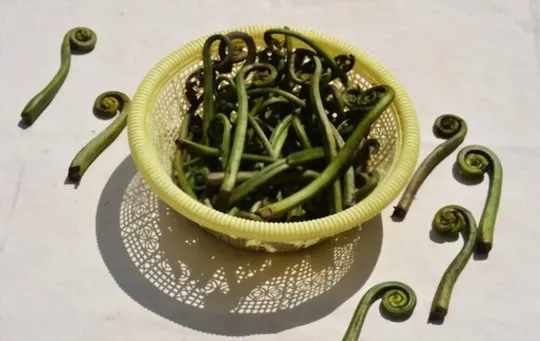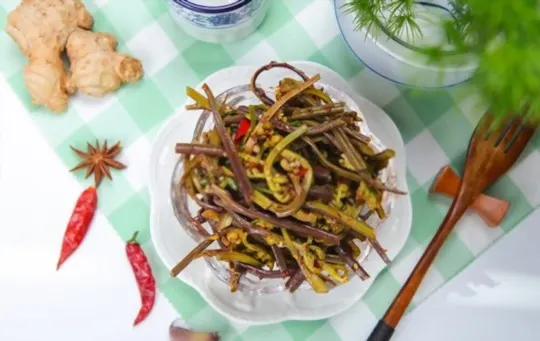You might’ve heard about this curled-up vegetable fiddlehead that resembles a fiddle’s head, but are you aware that this highly nutritious vegetable has been used for centuries by people globally?
Before, fiddleheads were eaten and used in various traditional cuisines across Northern France, by indigenous people of the United States, and all over Asia.
But it’s not entirely unbelievable since some studies suggest that they existed since the time of dinosaurs or beyond.
Today, it is celebrated as an extraordinarily nutritious and delectable vegetable that provides an array of health benefits.
Even though they grow almost everywhere, if you’ve never tried fiddleheads before and you wonder, “What do fiddleheads taste like?” You’ve come to the right place.
Find out what they actually are, what they taste like, and how you can best cook and serve them by reading the entire article.
What are Fiddleheads?

To be precise, fiddleheads are the neatly curled-up fronds on youthful ferns.
They clearly resemble the head of a fiddle, hence the name.
While fiddleheads are entirely okay to be eaten year-round, spring is the best time to cultivate them.
The neatly curled-up fronds open up after a period and are no longer edible.
They become extremely bitter tasting and are commonly known to be toxic, so assure yourself never to try and eat it after it is unfurled.
The most common reason why people enjoy fiddleheads is their unique taste profile.
Still, it is also because fiddleheads are known to be quite the healthy alternative to almost many vegetables.
The amazing health benefits fiddleheads offer us human beings include the prevention of cancer and diabetes, and they are also consumed to prevent various heart diseases.
Fiddleheads are also packed with a lot of nutrients and antioxidant properties.
Hence people consider it a superfood blessed by the heavens.
While the health benefits are not limited to the ones mentioned, it is clear that most health enthusiasts prefer incorporating fiddleheads into their diet to maintain or lose weight since they are also packed with fiber.
What Do Fiddleheads Taste Like?

Since we’re clear on what fiddleheads are and how they help us maintain a healthy lifestyle, let’s move on to what they taste like.
Most of us don’t eat food that tastes horrific to us, even though it may contain various nutrients to help us lead a healthy life.
Rest assured, fiddleheads may be the chosen greens that may change your view on vegetables.
A more common taste profile people might associate fiddleheads with would be the taste of asparagus.
Still, if you’re a vegetable enthusiast like us, you would straight away feel like you’re eating a mix of various greens.
The exact taste profile of fiddleheads can be summed up as being pleasantly sweet with a slight touch of earthiness and a touch of sharpness that enhances or complements any dish served.
While you can say that it is not common for this vegetable to taste otherwise, these delicate and delectable flavors may change depending on how you use or cook them.
How to Cook and Serve Fiddleheads?

Now that we have a clearer picture of what taste profile to expect when you eat fiddleheads let’s move on to how you can neatly cook and serve these delicious greens.
But before moving forward, ensure that your fiddleheads smell sweet and expect them to have a glorious freshly-picked greens aroma.
Once you do that, the rest is easy.
Fiddleheads are versatile veggies; you can cook them any way you want.
The most common way is sauteing them by adding other preferred delectable ingredients, but roasting them or choosing to bake or fry them also works like magic.
You can serve them as the main course or as a side to your favorite meat dishes.
Incorporating carbs on the side may also be perfect for your splendid evening dinner.
The possibilities are endless when handling fiddleheads, and they give you that perfect crunch if you’re wondering about their texture.
However, a necessary note to add is to ensure that it is cooked thoroughly before you choose a method.
Make sure to boil or steam your fiddleheads for approximately 11 minutes before you get to sauteing them or whatever type of cooling method you prefer.
You can even choose to eat them after its boiled or steamed but ensure you do it since these methods effectively remove the bitterness, and you will surely get those delicate flavors you’d be expecting.
Conclusion
Fiddleheads have been used in traditional cooking and recipes for centuries in most parts of the world.
Not only are they a healthy addition to your diet, but they are also extremely scrumptious.
But as we’ve mentioned, even though the aroma of freshly-picked fiddleheads might get too tempting, never consume them raw since they have toxins that may cause various illnesses.
Other than that, if you’re a vegetable enthusiast and prefer the sweet and earthy combo with terrific health benefits, fiddleheads might become the only vegetable you need.

Carrie is a food writer and editor with more than 15 years of experience. She has worked for some of the biggest names in the food industry, including Bon Appétit, Food & Wine, and Martha Stewart Living.
As the Editor in Chief of IntroChicago.com, Carrie oversees all of the content on the site. She also manages the team of contributing writers and editors, who help to create delicious recipes, helpful tips, and informative articles that you’ll find on the site.
A native of the Chicago area, Carrie is passionate about all things food. She loves trying new restaurants and experimenting with new recipes in her kitchen. She’s also a graduate of the Culinary Institute of America, so she knows a thing or two about food!
